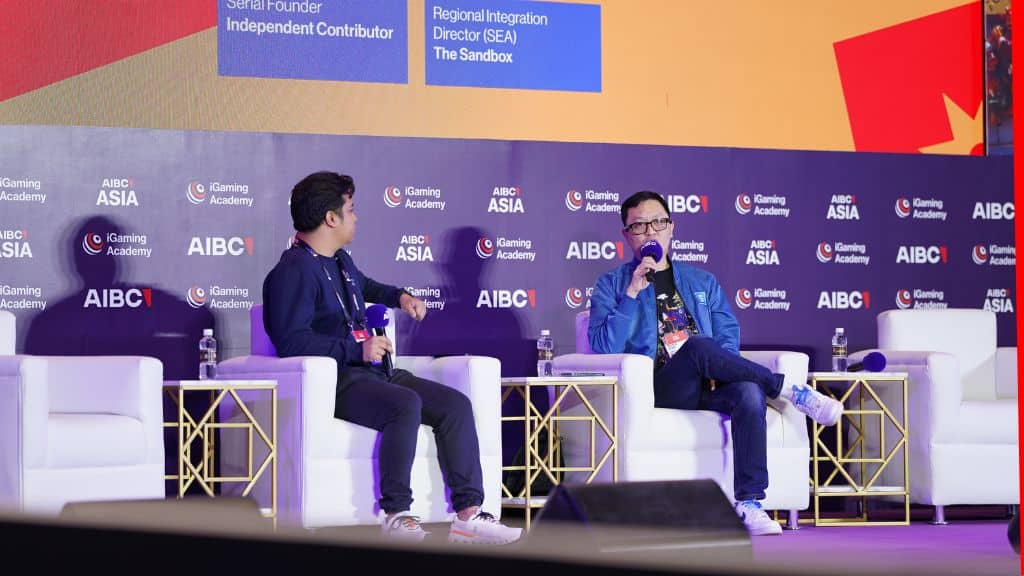- SUMMITS
- NEWS & MEDIA
- SUMMITS
- NEWS & MEDIA

The fireside chat at SiGMA Asia 2025 featuring George Wong, Regional Integration Director for Southeast Asia at The Sandbox, and Joe Josue, serial founder and independent contributor, presented an incisive snapshot of gaming’s decentralised future. Held on the Manila stage, this discussion unraveled The Sandbox’s positioning in the evolving Web3 and AI-enhanced gaming landscape, centred on user empowerment, creative sustainability, and technological inclusivity.
As George Wong aptly noted, gaming today is no longer confined to entertainment. It’s a pervasive societal force. “Our parents game, our children game… but it’s the type of game that they play that’s different.” Yet, a disconnect remains between marketers’ perceptions and gaming’s actual influence. The Sandbox is bridging that divide through its foundational belief in creator autonomy and economic sustainability.
Founded over a decade ago, The Sandbox initially thrived as a mobile gaming platform before pivoting to blockchain to enable creators to monetise their contributions. “We had a lot of creators who were building content on our platform, but they were not making money from it,” Wong explained. “So we wanted to introduce a way where content creators could control and monetise.”
Today, The Sandbox boasts a community of 8 million users, with Southeast Asia among its most significant and most active regions, a testament to its deep local resonance despite its international origins.
The conversation quickly shifted to the structural challenges that continue to plague Web3 games, chief among them an overemphasis on financial incentives at the expense of actual gameplay. “If people’s only reason to play your game is to make money, they might as well go iGaming,” said Wong. This monetisation-first mindset has prevented many Web3 titles from achieving mainstream success.
The Sandbox, by contrast, is doubling down on content quality, gameplay enjoyment, and community-driven creativity. “We now have about 3,000 published games on the platform,” Wong shared. “But in the grand scheme of things, that’s a minimal number. We need 10,000 indie games because one runaway success is what pushes us over the boundary of Web2 to Web3.”
Perhaps the most compelling part of the dialogue centred on AI’s role in democratising game development. With The Sandbox already operating as a no-code platform, AI introduces a quantum leap in creation speed and accessibility. “We build a generic scene and tell the AI, ‘I want to change this to a Christmas scene’… it does it in less than a minute,” Wong revealed.
This efficiency is critical for the user-generated content (UGC) model, The Sandbox champions. Wong compared it to how tools like CapCut and YouTube democratised video content. “Now with AI, even those not trained enough to work with a game dashboard can create environments and gameplay frameworks in weeks instead of months.”
However, the panel did not shy away from the disruptions AI could cause. “Every agency is going to get wiped out,” warned Wong. “Only the biggest ones that do the most complex things will survive… AI and robotics will eliminate physical and digital labour.” In this post-work era, Wong sees attention marketing, anchored in authenticity and creativity, as the new economic frontier.
While AI is being rapidly integrated into many creative domains, Wong pointed out a gap that remains underexplored: AI-powered NPCs. “Nobody is spending enough on this,” he lamented. “Imagine iGaming having AI NPC croupiers, lifelike, 24/7, always happy, always engaging.” The realism and emotional engagement of such characters, Wong argued, could mirror the immersion seen in films like Ready Player One, and make gaming worlds far more compelling.
Looking ahead, The Sandbox is testing various AI tools, including development kits and potentially AI agents, to lower friction across the board, from creation to payments. “We are actively pushing the boundaries… our platform and our games will evolve as AI implementation grows.”
And while not yet equipped with built-in AI NPC creation tools, The Sandbox is already in discussions to integrate such functionalities, further solidifying its position at the vanguard of decentralised gaming.
As Wong concluded, “I hope we create a solution that anyone can use. Like, one day you’ll say, ‘I’ve always wanted to build my own game’, and now you can.”
To keep up with the next wave of panels exploring the intersections of AI, gaming, and decentralisation, follow the SiGMA Asia 2025 agenda here: https://sigma.world/asia/agenda